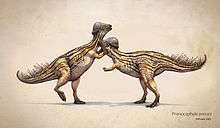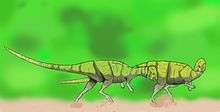Prenocephale
| Prenocephale Temporal range: Late Cretaceous, 80–75 Ma | |
|---|---|
| | |
| Cast of a P. prenes skull | |
| Scientific classification | |
| Kingdom: | Animalia |
| Phylum: | Chordata |
| Class: | Reptilia |
| Clade: | Dinosauria |
| Order: | †Ornithischia |
| Family: | †Pachycephalosauridae |
| Genus: | †Prenocephale Maryańska & Osmólska, 1974 |
| Species | |
| |
| Synonyms | |
| |
Prenocephale was a small pachycephalosaurid dinosaur genus from the Late Cretaceous (Campanian) of Mongolia and was similar in many ways to its close relative, Homalocephale, which may simply represent Prenocephale juveniles.
Description

Adult Prenocephale probably weighed around 130 kilograms (290 lb) and measured around 2.4 metres (8 ft) long. Unlike the flattened wedge-shaped skull of Homalocephale (a possible juvenile trait also potentially seen in early growth stages of Pachycephalosaurus), the head of Prenocephale was rounded and sloping. The dome had a row of small bony spikes and bumps. It lived in what is now Mongolia, but in high upland forests, not the dry deserts of Mongolia today.[1]
Like some other pachycephalosaurs, Prenocephale is known only from skulls and a few other small bones. For this reason, reconstructions usually depict Prenocephale as sharing the basic body plan common to all of the other Pachycephalosauria: a stout body with a short, thick neck, short forelimbs and tall hind legs.
The head of Prenocephale was comparable to that of Stegoceras, albeit with closed supratemporal fenestrae. Also, the paired grooves above the supraorbitals/prefrontals (along with a posterior parietal that restricts the frontal dome) are absent in Prenocephale. This differentiates the species from Stegoceras, as such features are common in the latter. It has been suggested that Prenocephale's supposed relatives, Sphaerotholus and Homalocephale, are all synoynms of Prenocephale. If this is the case, Prenocephale would have also lived in North America as well as in Mongolia.[2][3]
Classification
Prenocephale is a member of the Pachycephalosauria, a large clade of herbivorous/omnivorous dinosaurs from the Late Cretaceous.
Robert Sullivan considered Foraminacephale, "Prenocephale" edmontonensis, and Sphaerotholus goodwini to form a clade with the Asian taxon P. prenes. He considered Tylocephale the sister taxon to the Prenocephale clade, while sinking Sphaerotholus buchholtzae as a subjective junior synonym of "P." edmontonensis.[4][5] They all possess a distinct row of nodes on the squamosal and parietal areas of the skull roof.
Below is a cladogram modified from Evans et al., 2013.[6]
| Pachycephalosauria |
| ||||||||||||||||||||||||||||||||||||||||||||||||||||||||||||||||||||||||||||||||||||
| |
Paleobiology

As with most of its relatives, scientists do not yet know what these dinosaurs ate. However the premaxillary teeth and muzzle are not as wideset as in its relative Stegoceras, indicating different feeding preferences, possibly that Prenocephale was a more selective forager. Some scientists suggest that it may have been an omnivore, eating both plants and insects. However, most experts agree that Prenocephale (and the other pachycephalosaurs) browsed on leaves and fruit.
See also
References
- T. Maryanska and H. Osmolska. 1974. Pachycephalosauria, a new suborder of ornithischian dinosaurs. Palaeontologia Polonica 30:45-102.
- ↑ Palmer, D., ed. (1999). The Marshall Illustrated Encyclopedia of Dinosaurs and Prehistoric Animals. London: Marshall Editions. p. 137. ISBN 1-84028-152-9.
- ↑ Longrich, N.R., Sankey, J. and Tanke, D., 2010. Texacephale langstoni, a new genus of pachycephalosaurid (Dinosauria: Ornithischia) from the upper Campanian Aguja Formation, southern Texas, USA. Cretaceous Research, . doi:10.1016/j.cretres.2009.12.002
- ↑ Re: Sphaerotholus
- ↑ Robert M. Sullivan (2003). Revision of the dinosaur Stegoceras Lambe (Ornithischia, Pachycephalosauridae). of Vertebrate Paleontology: Vol. 23, No. 1, pp. 181–207.
- ↑ Dinosaurian Ungulates (Ornithopods)
- ↑ Evans, D. C.; Schott, R. K.; Larson, D. W.; Brown, C. M.; Ryan, M. J. (2013). "The oldest North American pachycephalosaurid and the hidden diversity of small-bodied ornithischian dinosaurs". Nature Communications. 4: 1828. Bibcode:2013NatCo...4E1828E. doi:10.1038/ncomms2749. PMID 23652016.


